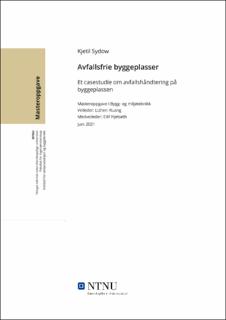Avfallsfrie byggeplasser Et casestudie om avfallshåndtering på byggeplassen
| dc.contributor.advisor | Huang, Lizhen | |
| dc.contributor.advisor | Hjelseth, Eilif | |
| dc.contributor.author | Sydow, Kjetil | |
| dc.date.accessioned | 2021-10-14T17:19:52Z | |
| dc.date.available | 2021-10-14T17:19:52Z | |
| dc.date.issued | 2021 | |
| dc.identifier | no.ntnu:inspera:78664360:16448912 | |
| dc.identifier.uri | https://hdl.handle.net/11250/2823135 | |
| dc.description.abstract | Utvikling den siste tiden har medført at man stadig blir mer bevisst på den negative påvirkningen menneskelig aktivitet og levesett har på naturen og dyrelivet. Den negative påvirkningen skjer på mange områder blant annet ved forurensning og at man forbruker ressurser på en måte som ikke er bærekraftig. Bygg- og anleggsbransjen (heretter omtalt som BA-bransjen) er sentral i begge disse kategoriene og i 2019 stod BA-bransjen for 24 % av avfallet fra norsk sektor. Som en målbar faktor på problemene er hovedfokuset i denne oppgaven avfall fra nybygg i BA-bransjen. Oppgaven undersøker flere aspekter rundt avfallsgenerering og håndtering på byggeplassen. Det gjøres blant annet ved besvarelse på disse tre forskningsspørsmålene: - Hvordan påvirker byggemetoden avfallsmengden? - Kan digitalisering bidra til avfallsreduksjon? - Hvordan arbeides det mot avfallsfrie byggeplasser? Informasjonsinnhentingen er gjort både ved tradisjonell litteraturstudie samt gjennomføring av en konseptdel. I konseptdelen inngår blant annet innhenting av informasjon fra et pågående pilotprosjekt innenfor avfallsfrie byggeplasser og sammenligning av ulike byggemetoder. Gjennomføringen bygger på kontakt med bransjen og inneholder oppdatert informasjon. Avfallsfrie byggeplasser er et relativt nytt begrep som har fått mye oppmerksomhet i BA-bransjen de siste årene. Konseptet blir promotert som løsningen for fjerning av alt avfall. I oppgaven konkluderes det med at produksjon i tråd med definisjonen til Avfallsfrie Byggeplasser-gruppen har et for høyt ambisjonsnivå som ikke er gjennomførbart i dagens byggeprosjekter. Konklusjonen bygger på dokumentert effekt fra ulike byggeprosjekter som er tilknyttet betegnelsen. Til tross for denne konklusjonen er undertegnede enig i at det er nødvendig med søkelys på avfallsreduksjon fra BA-bransjen, men settes ambisjonsnivået for høyt blir det urealistisk og kan være demotiverende. Det er videre sett på hvilke krav som stilles til avfallshåndtering på byggeplassen. Funnene i oppgaven tilsier at de statlige kravene er lite ambisiøse, og kun dekker en enkelt del av avfallsbildet. Loven sier at minimum 60 vektprosent av avfallet skal sorteres. Alle respondentene ligger godt over det kravet. En økning av det statlige kravet vil derfor kunne være hensiktsmessig. | |
| dc.description.abstract | Recent developments have led to an increasing awareness of the negative impact that human activity and lifestyles have on Earth’s flora and fauna. The negative impact that we put on the environment, is mostly from overconsumption and gas emissions. The construction industry is central in both categories and in 2019 the BA industry accounted for 24% of the waste from the Norwegian sector. As a measurable factor on these challenges, the focus of this thesis is waste from new construction in the industry. The thesis examines several aspects of waste generation as well as waste management on the construction site. This is, among other things, done by answering three research questions - How does the construction method affect the amount of waste generated? - Can digitalisation contribute to waste reduction? - How may we move towards «waste free construction sites»? Information for this thesis is collected both through traditional literature studies, as well as the implementation of a concept section. The concept section consists of obtaining information form an ongoing pilot project within «waste free construction sites», as well as comparing various construction methods. The implementation is based on contact with the industry, and consists of recent and updated information. The concept of waste free construction sites is relatively new and has received a lot of attention in the construction industry in recent years. The concept is being promoted as the solution to rid of all waste. However, this thesis concludes that production in accordance with the definition of «waste free construction sites» has too high a level of ambition that is not feasible in current construction projects. This claim is based on documented effects from various construction projects linked to the designation. Despite this conclusion, the undersigned agree that it is necessary to shed light on waste reduction from the construction industry. But if the level of ambition is set too high, it becomes unrealistic and can be demotivating. The thesis also looks into what requirements are set for waste management on construction sites. Findings indicate that the requirements made by the government are unambitious, and only covers one part of the waste dilemma. The law requires that a minimum of 60 % of all waste must be sorted. All respondents are well above this requirement. An increase in government requirements may therefore be appropriate. | |
| dc.language | nob | |
| dc.publisher | NTNU | |
| dc.title | Avfallsfrie byggeplasser Et casestudie om avfallshåndtering på byggeplassen | |
| dc.type | Master thesis |
